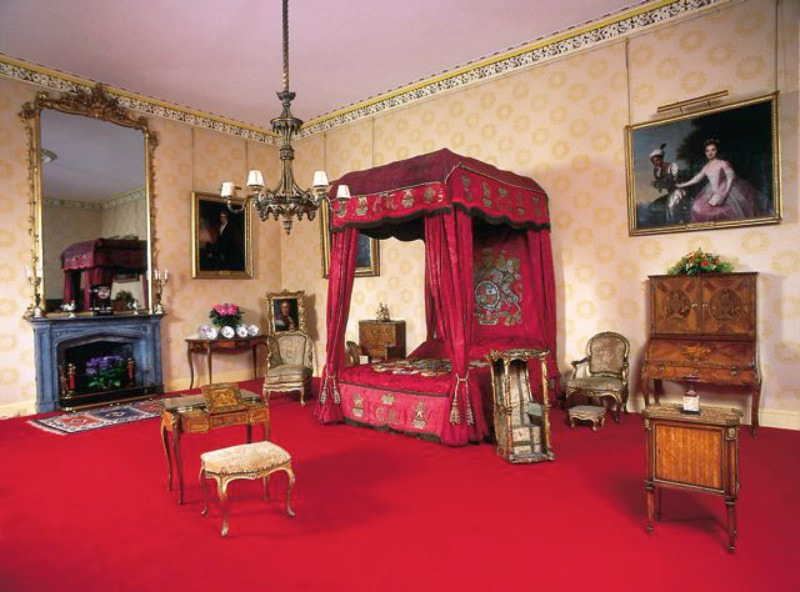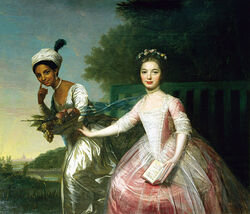

|
Scone Palace is the traditional location for the crowning of Scottish kings, including several who attempted the honor but did not achieve it. And the palace is full of legends and stories, enough to occupy many evenings of research. But since photos are not allowed inside, my account will be limited to the few I could find on line, such as the view above from wikipedia. Below, my shot, including a lonely tourist and a feeding peahen. Moot (or Boot) Hill was the site of Pictish Scotland kings' investiture in the 3rd century. When national Scottish councils were established, they were held here. An Augustinian abbey was built in the 12th century; Scone was also the site of the first parliament. By 1600, Scone was given by James VI to Sir David Murray, later named Lord Scone and 1st Viscount Stormont. Above, a replica of the famous adventurous Stone of Scone. It stands on Moot Hill before the Chapel, once the site of the Abbey. It is lso known as the Stone of Destiny. I had seen the Stone of Scone in Edinburgh Castle a few days earlier, where it is displayed with the crown jewels, the Honours of Scotland. It had been returned to Scotland in 1996, after being part of the British Coronation Chair in Westminster Abbey for many centuries. There is also the story about how the Stone was stolen from Westminster in 1950...as well as many other claims and legends that question the true nature and existence of the Stone. Which are authentic and which are substitutes or copies? The Chapel was remodeled in Gothic Style for the 3rd Earl of Mansfield (1777-1840), by William Atkinson. Below, the chapel at left, and right, an Italian alabaster memorial to Sir David Murray, 1st Viscount Stormont, by sculptor Maximilian Colt, in 1618. Please click on the small photos for larger versions. Below, sculptures on the grounds. Left, a Sword embedded in a stone, bringing to mind Excalibur. and Right, two handsome deer who seem poised to intimacy, but alas they are made of willow. Below, one of several white peacocks roaming the grounds. Left, my view; Right, doing a better display for the Telegraph. The Gothic door is as far as a I got with my phone camera. This version of the Palace was begun as a Regency Gothick House by Architect William Atkinson for the third Earl of Mansfield in 1803, replacing a medieval building. The interior, as portrayed by pictures from the website, is almost as perfectly Regency today as it was two hundred years ago. Above, the Octagon Room. The guidebook says, "Past and present come together in the Octagon Room,which was formerly part of the medieval gallery and led into the King's Room where Charles II slept the night before his coronation in 1651." Only months later, Charles II was defeated by Parliamentary forces of Oliver Cromwell and forced to flee to the continent where he remained until the Restoration of the monarchy in 1660. Octagonal rooms were often features of Regency-era decor. The Drawing Room boasts portraits of George III and Queen Charlotte. The 2nd Earl served as British ambassador. to France. These famous portraits were painted by artist Allan Ramsay, a Scot who was also a 2nd cousin by marriage to the 2nd Earl. At right, William Murray, 1st Earl of Mansfield, Lord Chief Justice of Great Britain (1705-1793), painted by Sir Joshua Reynolds in 1776. He was renowned for his decisions which ended slavery in Britain.  The Ambassador's Room, above, displays furniture from the 2nd Earl's tenures in Paris and Vienna. At the upper right is the famous portrait of Dido Bell and Lady Elizabeth Murray, daughter of the 2nd Earl of Mansfield. Both young ladies lived with the 1st Earl and his wife at Kenwood House, a Murray residence at the edge of Hampstead Heath in London.  Dido's story was told, relatively accurately, by the 2013 film Belle. The portrait, once attributed to Johann Zoffany but now thought more likely to be by David Martin, hangs here because the Murrays gave up Kenwood House for continual residence at Scone in the early 20th century. The Inner Hall displays numerous family heirlooms, perhaps most obviously two Russian bears shot by Sir Lancelot Carnegie, maternal great-grandfather of the present earl, in 1908 when he was secretary at the British Embassy in Moscow. I would love to show you much more of this fascinating palace, but it isn't easy to find the images on line. So if I had anything to do with the marketing of tourism at Scone, I would immediately allow cameras and then rejoice as the visitors post their many pictures -- thus attracting many more. This is the policy of many wonderful castles, palaces, and manor houses all over Britain. I think they are benefiting from allowing photos. Are you listening Glamis and Scone? Above photo from https://www.smallcitybigpersonality.co.uk/
0 Comments
Leave a Reply. |
Victoria Hinshaw, Author
Archives
July 2024
Categories |
